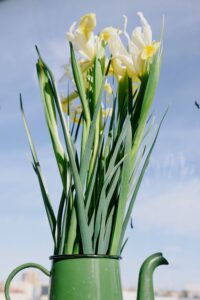Daffodils (Narcissus) are iconic spring-blooming flowers known for their vibrant colors and trumpet-shaped blooms. Belonging to the Amaryllidaceae family, daffodils are perennial plants that emerge from bulbs and grace gardens with their cheerful presence. Daffodils feature a unique structure with a central trumpet-shaped corona (trumpet) surrounded by six petal-like tepals, forming the characteristic bloom. Narcissus are long-lived perennials, and once established, they can return year after year, providing a reliable burst of color in early spring.
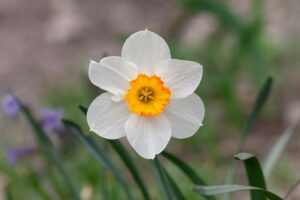
Daffodils grow from bulbs, which are underground storage structures that contain the nutrients needed for the plant to sprout and bloom. Daffodils feature long, strap-like leaves that emerge from the base of the plant. The leaves are typically green and provide an attractive backdrop to the flowers. They exhibit a clumping or solitary growth habit, creating visually appealing displays in gardens. Daffodil plants vary in height, with some shorter varieties suitable for borders and others reaching taller heights.
The iconic daffodil flower consists of a central trumpet-shaped corona (trumpet) surrounded by six petal-like tepals. Tepals refer to the outer floral segments that are not clearly differentiated into petals and sepals. Daffodils come in various colors, with the most common being shades of yellow and white. Some varieties exhibit orange, pink, or bicolor blooms. Daffodils are early spring bloomers, typically flowering from late winter to early summer. The exact bloom time can vary based on the variety and local climate. They are suitable for various gardening styles, including formal gardens, borders, rock gardens, and naturalized settings.
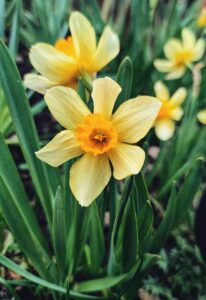
Many daffodil varieties are pleasantly fragrant, emitting a sweet and delicate scent that adds to their allure.
Daffodils contain toxic compounds, especially in their bulbs, which can cause discomfort if ingested. It’s important to handle them with care.
Sunlight Requirement
Daffodils prefer planting locations that receive full sun to partial shade. Full sun refers to at least 6 hours of direct sunlight per day. Daffodils are well-suited for naturalizing in lawns. They can tolerate partial shade, making them suitable for areas where trees or other structures may provide dappled sunlight.
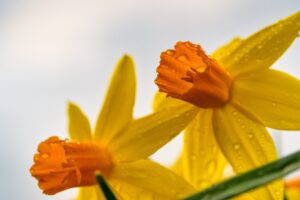
Temperature and Humidity Requirement of Daffodils
Daffodils are well-suited to cool to temperate climates. Daffodils thrive in temperatures ranging from 50°F to 70°F (10°C to 21°C) during their active growing season. These cooler temperatures are conducive to robust foliage and flower development. Daffodil bulbs typically require a period of chilling (cold dormancy) to initiate flowering. This chilling period simulates winter conditions and is necessary for the development of flower buds. Daffodils are cold-tolerant and can withstand frost. Daffodils are adaptable to a wide range of humidity levels. They can grow successfully in both humid and drier climates.
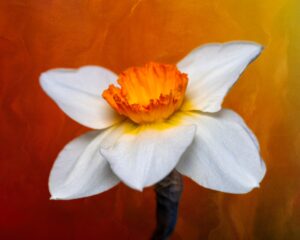
Soil Requirement of Daffodil Flower
Daffodils prefer well-drained soil that prevents waterlogging. Daffodils thrive in slightly acidic to slightly alkaline soil with a pH range between 6.0 and 7.0. Daffodil bulbs are typically planted at a depth of two to three times their height. Loose and friable soil makes it easier for the bulbs to establish roots and allows for proper expansion as they grow. Prepare the planting area by loosening the soil to a depth of at least 8 to 12 inches (20 to 30 cm). This helps the bulbs establish a strong root system and promotes overall plant health.
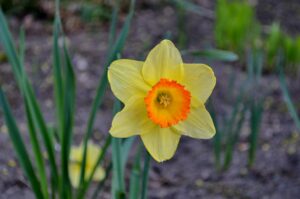
Propagation of Daffodils Flower through Bulb
Daffodils (Narcissus) are commonly propagated through bulbs. Here’s a guide on the propagation and sowing of daffodil flowers through bulbs:
Propagation through Bulbs:
Division:
Daffodil bulbs multiply naturally through a process called division. Over time, a single bulb can produce offsets or bulblets. These offsets can be gently separated from the parent bulb when the foliage has withered after blooming.
Lifting and Separating Bulbs:
Lift the daffodil bulbs from the ground once the foliage has turned yellow and withered, typically in late spring to early summer. Gently separate the offsets from the main bulb. Each offset should have some roots attached.
Bulb Storage:
Store the separated bulbs in a cool, dry place until the fall planting season. Avoid exposing them to direct sunlight or excessive moisture during storage. In the fall, plant the separated bulbs in well-prepared soil.
Sowing of Daffodil Bulbs
Choose healthy, firm bulbs for planting. Bulbs that are large and free from disease or damage are more likely to produce vigorous plants and beautiful blooms.
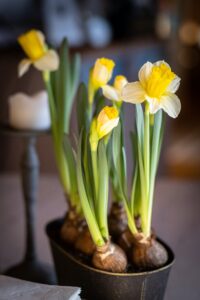
The best time to plant daffodil bulbs is in the fall, several weeks before the ground freezes. This allows the bulbs to establish roots before winter.
Prepare the planting area by loosening the soil and adding organic matter. Ensure good drainage to prevent waterlogging, which can lead to bulb rot.
Plant the daffodil bulbs at a depth of about 6 to 8 inches (15 to 20 cm) in well-drained soil. Follow spacing recommendations to allow for proper air circulation between plants.
Water the bulbs well after planting to help settle the soil and initiate root growth. However, avoid overwatering to prevent bulb rot.
Daffodils planted from bulbs typically bloom in the spring, adding beauty to gardens and landscapes. Proper care during the planting process and ensuring the bulbs have adequate time to establish roots are key to successful daffodil propagation through bulbs.
Water Requirements of Daffodil flower
During the period when daffodils are actively growing and establishing roots, provide consistent moisture. This is especially crucial in the fall when the bulbs are planted and in the spring when they are actively growing foliage. Daffodils generally require less water during their flowering period. However, if the weather is exceptionally dry, providing some supplemental watering can help extend the bloom time. Daffodils are susceptible to bulb rot if the soil remains consistently waterlogged. Ensure that the planting area has well-drained soil to prevent water-related issues.
Once the daffodils have finished blooming and the foliage begins to yellow and wither, gradually reduce watering. This signals the bulbs to enter a dormant phase. Once the foliage has completely died back, the bulbs can tolerate drier conditions.
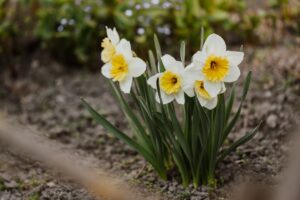
Fertilizer Requirement of Daffodils
Apply fertilizer in the fall when planting daffodil bulbs and again in the spring as the foliage emerges. This timing helps provide essential nutrients for both bulb establishment and flower development. Use a balanced, slow-release fertilizer with a ratio such as 10-10-10 or 5-10-5. Follow the recommended application rates specified on the fertilizer packaging. Typically, a handful of fertilizer per square foot of planting area is sufficient. Daffodils do not require excessive amounts of nitrogen.

After flowering care of Daffodils
Remove spent flowers by deadheading. This prevents the plant from expending energy on seed production and encourages the bulb to store energy for the next flowering season.
Allow the daffodil foliage to remain in place until it turns yellow and begins to wither naturally. The leaves are essential for photosynthesis, which helps recharge the bulb for the next year’s bloom.
Apply a balanced, slow-release fertilizer or a bulb fertilizer around the base of the plants after flowering. This provides essential nutrients for the bulb’s growth and development.
Continue to water the daffodil plants if rainfall is insufficient. Adequate moisture is necessary for the bulbs to store energy for the next growing season.
Refrain from cutting back daffodil foliage until it has turned yellow and begins to wither. Premature removal can weaken the bulb.
If your daffodil clumps have become overcrowded, consider dividing and replanting the bulbs. Wait until late spring or early summer when the foliage has withered completely. Lift the bulbs, separate them, and replant them at the appropriate depth.
If you’ve lifted the bulbs for division or other reasons, store them in a cool, dry place until the fall planting season. Ensure good ventilation and avoid exposure to excessive moisture.
Ornamental Uses of Daffodils
Daffodils (Narcissus) are popular spring-blooming flowers with bright, trumpet-shaped blooms. Their ornamental uses are diverse, making them a beloved choice for gardens, landscapes, and floral arrangements. Here are some ornamental uses of daffodil flowers:
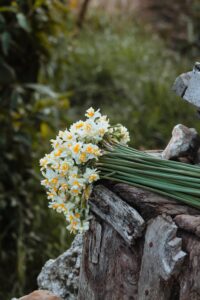
Garden Displays: Daffodils are commonly planted in gardens and flower beds for their vibrant and cheerful blooms. They add a burst of color to spring landscapes, creating a welcoming and visually appealing environment.
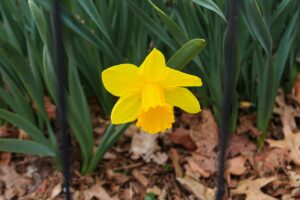
Naturalizing in Lawns: Daffodils naturalize well, meaning they multiply and come back year after year. Many gardeners plant daffodils in lawns, meadows, or wooded areas to create naturalized displays that require minimal maintenance.
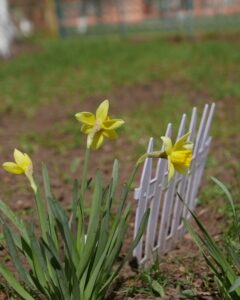
Cut Flower Arrangements: Daffodils make excellent cut flowers for floral arrangements. Their long stems and bold, trumpet-shaped blooms add elegance to bouquets and indoor displays. When arranged with other spring flowers, they create stunning centerpieces.

Container Gardening: Daffodils are well-suited for container gardening. Planting them in pots or containers allows you to enjoy their blooms on patios, balconies, or other small spaces. Container-grown daffodils can be moved around to create dynamic displays.
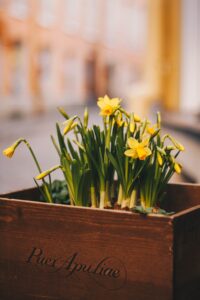
Rock Gardens: Dwarf and miniature daffodil varieties are ideal for rock gardens. Their smaller size and delicate blooms complement the scale and aesthetics of rock features, adding color and interest to these specialized garden designs.
Borders and Edges: Daffodils are often used as borders or edging plants along pathways and garden borders. Their upright stems and colorful flowers create defined lines and borders in garden designs.
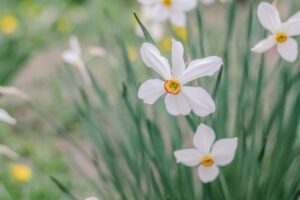
Forcing Indoors: Daffodil bulbs can be forced to bloom indoors during the winter months. Planted in pots and brought indoors, they provide an early burst of spring color, lifting spirits during the colder seasons.
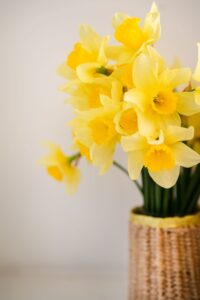
Whether planted in a naturalized setting or featured as individual specimens, daffodils bring beauty and charm to various settings, making them a versatile and cherished ornamental flower.
Problems While Growing Daffodil Flowers
While daffodils (Narcissus) are generally hardy and low-maintenance flowers, they can face certain problems during their growth. Here are some common issues encountered when growing daffodils and suggestions for addressing them:
Pests:
Narcissus Bulb Fly: The larvae of this fly can damage daffodil bulbs. Apply insecticides or use protective covers to prevent infestation.
Slugs and Snails: These pests may feed on daffodil foliage and flowers. Use slug and snail baits or other control methods to protect the plants.
Diseases:
Basal Rot: A fungal disease that affects the base of the bulb, causing rotting. Plant bulbs in well-draining soil and avoid overwatering to prevent this disease.
Fungal Leaf Diseases: Daffodils can be susceptible to fungal leaf spot diseases. Provide adequate air circulation, avoid overhead watering, and apply fungicides if necessary.
Bulb Problems:
Soft Rot: Excessive moisture can lead to bulb rot. Plant daffodils in well-draining soil, and ensure that the planting site doesn’t become waterlogged.
Planting Too Shallow or Deep: Improper planting depth can affect blooming. Plant bulbs at a depth of about 6 inches (15 cm) with the pointed end facing upward.
Flowering Issues:
No Flowers or Few Flowers: This may occur if the bulbs are overcrowded, planted too shallow, or if the plants receive insufficient sunlight. Divide overcrowded clumps, plant at the correct depth, and ensure adequate sunlight.
Deer and Rodent Damage: Deer and rodents may browse on daffodil foliage and flowers. Use protective measures such as fencing or apply deer repellents to deter them.
Virus Issues: Daffodils can be affected by mosaic viruses, leading to mottled or distorted foliage. Remove and destroy infected plants to prevent the spread of the virus.
Regularly inspecting daffodil plants for signs of pests, diseases, or cultural issues can help address problems promptly. Implementing good gardening practices, such as proper planting depth, well-draining soil, and appropriate watering, contributes to the overall health and resilience of daffodil flowers.
